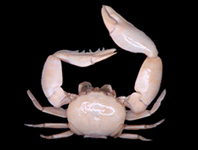Abstract
The extinct hemipteran family Dysmorphoptilidae was a major component of the Triassic insect fauna of Queensland preserved at the Denmark Hill, Dinmore, Mount Crosby and Gayndah fossil insect sites. A total of 13 species have now been identified, of which eight species in five genera were examined in the first part of this revision. This second part revises the remaining five species in three genera. Eoscartoides Evans, 1956 (= Mesonirvana Evans, 1956, syn. nov.), comprising Eoscartoides bryani Evans, 1956 (= Mesonirvana abrupta Evans, 1956, syn. nov.) (Mount Crosby), Eoscartoides orthocladus (Tillyard, 1922) comb. nov. (Denmark Hill), and Eoscartoides dmitryi sp. nov. (Dinmore), is distinguished by a strongly developed arc-like strigil in the basal costal space, a very short stem of RA, and a deeply forked M1+2. The monotypic Eoscarterella Evans, 1956, with type species Eoscarterella media Evans, 1956 (Mount Crosby), has a strongly lobate tegmen with peculiar surface sculpture and M1+2 simple. Eoscartoides and Eoscarterella differ from most dysmorphoptilids in having more or less lobate tegmina with even margins (without the antero-apical emargination so typical of the family), as well as the early entry of RA1 into the costal margin and the associated extensive and antero-apically positioned RA2. These characters are also shared with two other dysmorphoptilids, the Australian Permian Belmontocarta Evans and an unnamed Triassic species from Kyrgyzstan, and the four thus form a distinct subgroup within the family. On the other hand, the monotypic Trifidella Evans, 1956 (= Alotrifidus Evans, 1956, syn. nov.), with type species Trifidella perfecta Evans, 1956 (= Alotrifidus interruptus Evans, 1956, syn. nov.) (Mount Crosby), is a more typical dysmorphoptilid with a distinct emargination, RA entering the margin much more apically, and RA2 of limited extent. Trifidella is presumably the sister of the Queensland Triassic Dysmorphoptiloides Evans, sharing the basal fusion of M and CuA.
References
Becker-Migdisova, E.E. (1960) New Permian Homoptera from the European part of the USSR. Trudy Paleontologicheskogo Instituta Akademia Nauk SSSR, 76, 1–112.
Emeljanov, A.F. (1987) Phylogeny of Cicadina (Homoptera) based on comparative morphological data. Trudy Vsesoyuznogo entomologicheskogo obshchestva, 69, 19– 109.
Evans, J.W. (1956) Palaeozoic and Mesozoic Hemiptera (Insecta). Australian Journal of Zoology, 4, 165–258.
http://dx.doi.org/10.1071/ZO9560165Evans, J.W. (1958) New Upper Permian Homoptera from the Belmont Beds (Homoptera: Insecta). Records of the Australian Museum, 24, 109–114.
http://dx.doi.org/10.3853/j.0067-1975.24.1958.647Evans, J.W. (1961) Some Upper Triassic Hemiptera from Queensland. Memoirs of the Queensland Museum, 14, 13–23.
Evans, J.W. (1971) Some Upper Triassic Hemiptera from Mount Crosby, Queensland. Memoirs of the Queensland Museum, 16, 145–151.
Hamilton, K.G.A. (2012) Revision of Neotropical aphrophorine spittlebugs, part 1: Ptyelini (Hemiptera, Cercopoidea). Zootaxa, 3497, 41–59.
Jell, P.A. (2004) The fossil insects of Australia. Memoirs of the Queensland Museum, 50, 1–124.
Lambkin, K.J. (2015) Revision of the Dysmorphoptiidae with emarginate tegmina (Hemiptera: Auchenorryncha: Cicadomorpha: Prosboloidea) of the Queensland Triassic. Zootaxa, 3936 (3), 357–374.
http://dx.doi.org/10.11646/zootaxa.3936.3.3Pinto, I.D. (1990) Permian insects from Paraná Basin, South Brazil VI. Homoptera—3. Fulgoringruidae. Pesquisas, 17, 3–6.
Shcherbakov, D.E. (1984) Systematics and phylogeny of Permian Cicadomorpha (Cimicida and Cicadina). Paleontological Journal, 1984, No. 2, 87–97.
Shcherbakov, D.E. (1996) Origin and evolution of the Auchenorrhyncha as shown by the fossil record. In: Schaefer, C.W. (Ed.), Studies on Hemipteran Phylogeny. Entomological Society of America, Lanham, Maryland, pp. 31–45.
Shcherbakov, D.E. (2000) Permian faunas of Homoptera (Hemiptera) in relation to phytogeography and the Permo-Triassic crisis. Paleontological Journal, 34, 251–267.
Shcherbakov, D.E. (2011) New and little-known families of Hemiptera Cicadomorpha from the Triassic of Central Asia—early analogs of treehoppers and planthoppers. Zootaxa, 2836, 1–26.
Shcherbakov, D.E. & Popov, Y.A. (2002) Superorder Cimicidea Laicharting, 1781 Order Hemiptera Linné, 1758. The bugs, cicadas, plantlice, scale insects, etc. (=Cimicida Laicharting, 1781, = Homoptera Leach, 1815 + Heteroptera Latreille, 1810). In: Rasnitsyn, A.P. & Quicke, D.L.J. (Eds.), History of Insects. Kluwer Academic Publishers, Dordrecht, pp. 143–157.
Tillyard, R.J. (1922) Mesozoic insects of Queensland. No.9. Orthoptera, and additions to the Protorthoptera, Odonata, Hemiptera and Planipennia. Proceedings of the Linnean Society of New South Wales, 47, 447–470.
Wang, B., Szwedo, J., Zhang, H. & Fang, Y. (2010) The major diversification of Cicadomorpha in the Jurassic (Insecta: Hemiptera). Earth Science Frontiers, 17, 186–187.

